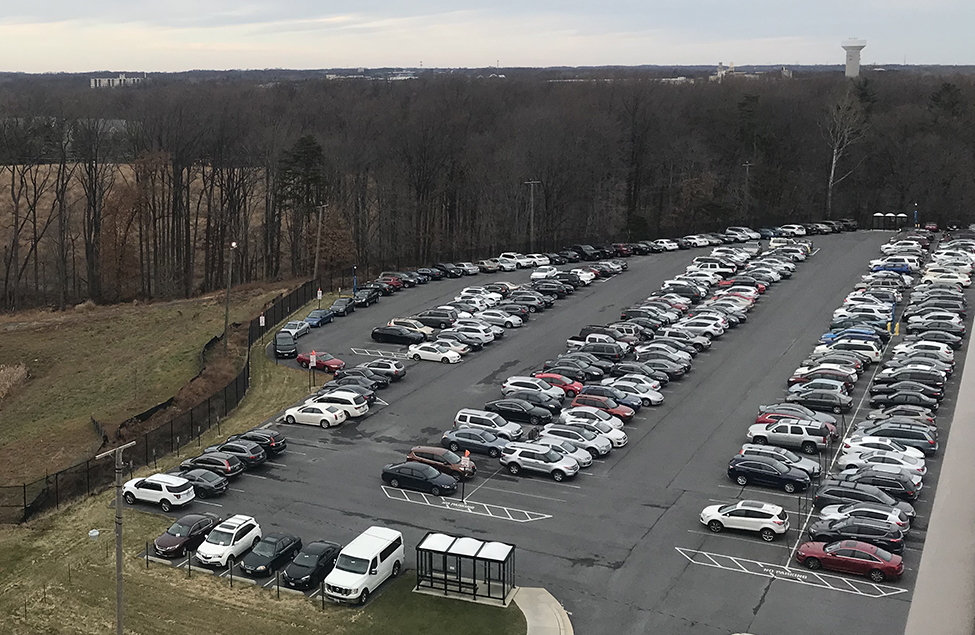
- By Kael Anderson
- December 19, 2017
National Capital Region Federal Parking Study Released
In October 2017, the Commission accepted a parking study that will inform its future transportation policies and could shape federal facility development and regional transportation patterns. The full study is available online, but for a quick overview, the study’s three key components are outlined below.
NCPC's Current Policies and Parking Ratios
As part of its regional planning role, NCPC promotes a multi-modal regional transportation system that meets the travel needs of federal workers, residents, and visitors in the National Capital Region, while improving regional mobility and air quality through transit-oriented development. The primary mechanisms to implement this are explicit, geographically-based federal facility parking ratio policies in NCPC’s Comprehensive Plan. During the past several decades, NCPC’s parking policies have served as one of the agency’s most valuable and effective policy tools.
The parking ratio policies are based on geographic zones. Each zone approximates regional accessibility based on the distance to downtown Washington, DC and proximity to Metrorail stations and high-occupancy vehicle/high-occupancy toll lanes. For example, federal facilities that are within 0.5 miles of a Metro station should achieve a 1:4 parking ratio (1 parking space for every 4 employees). These policies limit parking supply in areas where transit accessibility is high and employee carpooling is more likely, while allowing for more parking spaces in outlying suburban areas.
Three Components of the Study
In light of changing transportation accessibility patterns in the region, NCPC asked the U.S. Department of Transportation’s John A. Volpe National Transportation Systems Center (Volpe) to assess NCPC’s current parking ratio policies. The study included a literature review, a local parking practices comparison, and a modeling analysis.
The literature review identified industry best practices, transportation concepts, and analytical approaches that inform parking supply decisions. It reported how transportation policies that focus on moving people rather than moving and parking vehicles result in considerable land-use, transportation, and construction efficiencies. One example identified in the literature review was from Texas Instruments, which offers onsite concierge services and various amenities to reduce the need for off-site errands. Another case study focused on the University of California, Los Angeles, which developed a detailed need-based parking permit allocation system.
The local parking comparison studied parking policies in nearby regional jurisdictions. Volpe found that NCPC is a national leader in parking policy: jurisdictions across the country are increasingly employing approaches that NCPC first adopted over thirty years ago. In addition, the study team’s survey identified several local practices that may be helpful reference points for NCPC. For example, Montgomery County, Maryland sets mode share goals and routinely monitors performance in specified Transportation Management Districts. Arlington County, Virginia developed a flexible, data-driven review process that enables developers to meet stricter parking requirements.
To validate NCPC’s current parking ratios, the modeling analysis calculated the relative convenience of reaching each location in the region by transit and automobile. It found that accessibility will improve significantly by 2030 in the region’s core due to planned transportation improvements, projected household growth, and changes in congestion. Based on the analysis, the study recommended realigning NCPC’s parking policies to more closely reflect these regional accessibility trends and advancing complementary travel demand management strategies, such as providing shuttles from federal campuses to nearby Metro stations.
Next Steps
NCPC staff is meeting with stakeholders, including federal and District agencies, to review the study’s findings, conclusions and recommendations. Over the next year, NCPC will consider updates to its transportation policies, guidelines, and plan development processes. You can review the study and NCPC’s existing policies via the links below.
NCR Federal Parking Study Presentation Video Federal Transportation Element


